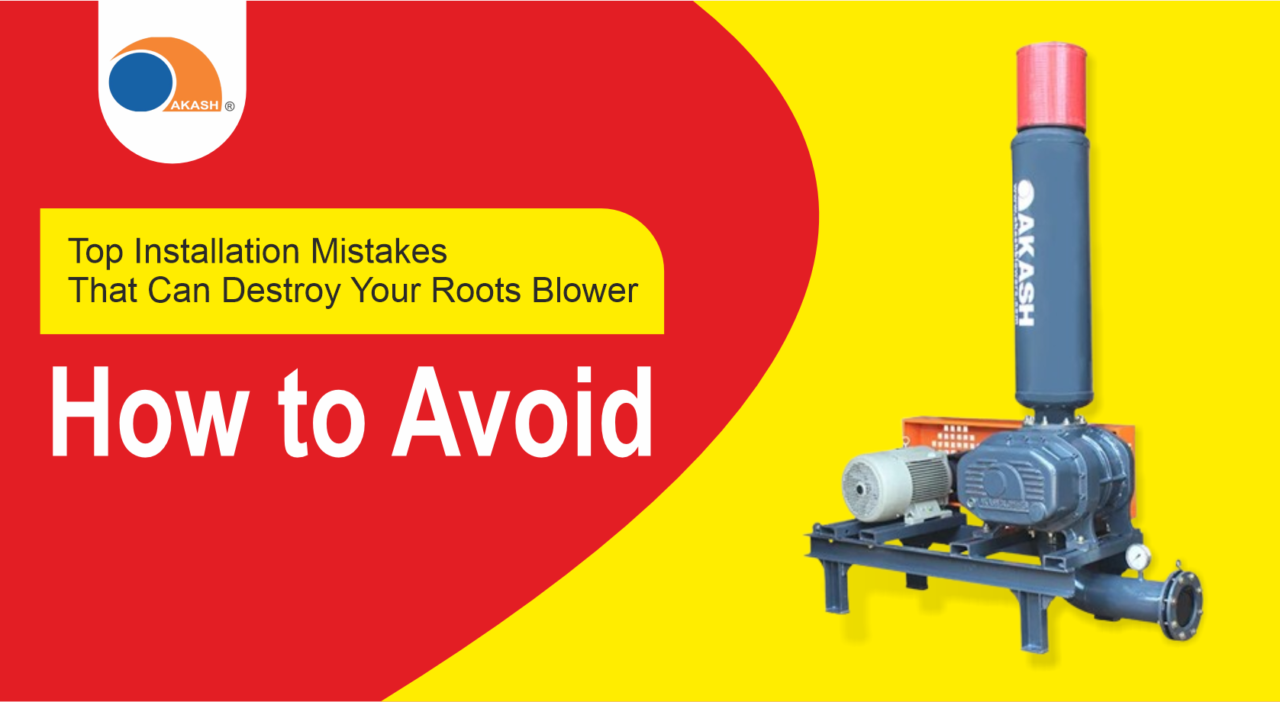Roots blowers are vital pieces of equipment in industries like wastewater treatment, pneumatic conveying, and aquaculture. Known for their reliability and efficiency, these positive displacement machines move large volumes of air or gas with precision. However, even the best Roots blower can fail prematurely if not installed correctly. Installation mistakes can lead to costly repairs, downtime, and reduced performance. In this comprehensive guide, we’ll explore the top installation mistakes that can destroy your Roots blower and provide practical tips on how to avoid them. Whether you’re a seasoned technician or a first-time user, this blog will help you ensure your Roots blower operates at its peak for years to come.
Let’s dive into the common pitfalls and how to steer clear of them, with expert insights inspired by industry leaders like Akash Blowers, a trusted name in high-performance Roots blowers.
Why Proper Installation Matters for Your Roots Blower
Before we get into the mistakes, let’s understand why installation is so critical. A Roots blower operates by using two rotating lobes to trap and move air or gas from the inlet to the outlet. This process involves high speeds, tight tolerances, and precise alignment. Any misstep during installation can throw off this delicate balance, leading to vibration, overheating, or even catastrophic failure. Proper installation not only extends the lifespan of your Roots blower but also ensures energy efficiency and consistent output—key factors in industrial applications.
Now, let’s uncover the top installation mistakes and how you can avoid them to protect your investment.
Mistake #1: Ignoring the Foundation and Base Preparation
The Problem
One of the most overlooked aspects of Roots blower installation is the foundation. A weak, uneven, or unstable base can cause misalignment, excessive vibration, and premature wear on bearings and gears. Many users assume any flat surface will do, but Roots blowers require a solid, level foundation to handle their operational stresses.
The Consequences
-
Vibration Damage: An unstable base amplifies vibrations, stressing the blower’s components.
-
Misalignment: Uneven surfaces can misalign the blower, leading to rotor friction and overheating.
-
Reduced Lifespan: Constant strain on the machine shortens its operational life.
How to Avoid It
-
Choose a Stable Location: Install your Roots blower on a concrete pad or a rigid steel frame. The surface should be flat within 0.002 inches to prevent twisting.
-
Use Shims: If the base isn’t perfectly level, use shims under the blower’s feet to ensure even contact.
-
Secure It Properly: Bolt the blower firmly to the foundation to minimize movement during operation.
For high-quality Roots blowers designed for easy installation, check out Akash Blowers, where precision engineering meets durability.
Mistake #2: Improper Piping Alignment and Support
The Problem
Piping issues are a silent killer for Roots blowers. Misaligned or unsupported pipes can exert strain on the blower’s inlet and outlet flanges, causing leaks, vibration, and even casing distortion. Some installers rush this step, assuming the blower can handle the stress—but it can’t.
The Consequences
-
Leaks: Poor alignment leads to gaps, reducing efficiency and allowing contaminants in.
-
Component Wear: Excessive strain wears out seals, bearings, and rotors faster.
-
Noise Increase: Misaligned pipes amplify operational noise, a common complaint in industrial settings.
How to Avoid It
-
Align Pipes Precisely: Ensure the piping aligns perfectly with the blower’s flanges without forcing connections.
-
Support the Piping: Use independent supports or hangers to bear the weight of the pipes, not the blower itself.
-
Check for Strain: After installation, loosen one bolt on the blower’s foot. If a 0.002-inch shim slides under, add shims to relieve pipe strain.
Proper piping setup is key to maximizing your Roots blower’s performance—something Akash Blowers emphasizes in their installation guides.
Mistake #3: Neglecting Ventilation and Temperature Control
The Problem
Roots blowers generate heat during operation, and poor ventilation can trap this heat, pushing the machine beyond its safe temperature range. Installing a blower in a cramped, hot, or poorly ventilated space is a recipe for disaster.
The Consequences
-
Overheating: Excessive heat damages lubricants, seals, and internal components.
-
Efficiency Loss: High temperatures reduce air density, lowering the blower’s output.
-
Safety Risks: Overheating poses a burn hazard and increases the risk of failure.
How to Avoid It
-
Ensure Adequate Space: Leave enough room around the blower for air circulation—check the manufacturer’s clearance recommendations.
-
Install Cooling Systems: In hot climates (above 40°C), consider ducted air inlets or cooling fans to maintain optimal temperatures.
-
Monitor Conditions: Use temperature sensors to keep tabs on the blower’s operating environment.
For blowers built to handle tough conditions, explore the range at Akash Blowers, designed with durability in mind.
Mistake #4: Skipping Pre-Installation Checks
The Problem
Jumping straight into installation without inspecting the Roots blower or its components is a common rookie mistake. Shipping damage, loose parts, or factory defects can go unnoticed, leading to immediate issues once the blower starts running.
The Consequences
-
Instant Failure: Damaged rotors or bearings can seize up on startup.
-
Warranty Issues: Operating a faulty unit may void your warranty if not reported pre-installation.
-
Costly Repairs: Early damage compounds into bigger problems down the line.
How to Avoid It
-
Inspect on Arrival: Check the blower for dents, cracks, or loose bolts before installation.
-
Rotate by Hand: Manually turn the rotors to ensure they move freely without grinding or resistance.
-
Verify Accessories: Confirm all components (filters, silencers, belts) are included and undamaged.
Akash Blowers ships their units with detailed checklists to make this step foolproof.
Mistake #5: Incorrect Belt or Drive Alignment
The Problem
Many Roots blowers use V-belts or direct drives to connect to motors. Misaligned belts or improper tension can throw off the entire system, causing slippage, overheating, or uneven wear.
The Consequences
-
Power Loss: Slippage reduces the blower’s efficiency and output.
-
Belt Wear: Misalignment wears out belts quickly, leading to frequent replacements.
-
Bearing Damage: Excess tension strains the blower’s bearings, shortening their life.
How to Avoid It
-
Align Pulleys: Use a straightedge or laser tool to ensure the motor and blower pulleys are perfectly aligned.
-
Set Proper Tension: Follow the manufacturer’s specs for belt tension—too tight or too loose is trouble.
-
Check Regularly: Inspect belts for wear and realign as needed during maintenance.
For Roots blowers with reliable drive systems, Akash Blowers offers models designed for seamless integration.
Mistake #6: Overlooking Lubrication Requirements
The Problem
Roots blowers rely on lubrication to keep gears and bearings running smoothly. Failing to add the right type or amount of oil before startup—or skipping this step entirely—can cause immediate damage.
The Consequences
-
Friction Damage: Dry components grind together, ruining gears and bearings.
-
Overheating: Lack of lubrication spikes operating temperatures.
-
Seized Rotors: Without oil, the blower can lock up completely.
How to Avoid It
-
Use Recommended Oil: Check the manual for the correct lubricant type (synthetic or mineral-based).
-
Fill to Spec: Add oil to the specified level—overfilling is as bad as underfilling.
-
Check Before Startup: Verify oil levels and look for leaks after filling.
Akash Blowers provides clear lubrication guidelines with every unit to prevent this mistake.
Mistake #7: Running Without Proper Safety Devices
The Problem
Roots blowers need safety features like pressure relief valves and vacuum switches to protect against overpressure or blockages. Skipping these can push the blower beyond its limits.
The Consequences
-
Blower Damage: Excess pressure warps rotors or cracks the casing.
-
System Failure: Blockages can halt downstream processes.
-
Safety Hazards: Overpressure risks explosions or equipment blowouts.
How to Avoid It
-
Install Relief Valves: Add a pressure relief valve on the discharge line to vent excess pressure.
-
Use Vacuum Switches: Place a switch at the inlet to shut off the blower if suction drops too low.
-
Test Regularly: Ensure safety devices are functional before and after installation.
Final Tips for a Flawless Roots Blower Installation
Avoiding these top installation mistakes sets the stage for a long-lasting, efficient Roots blower. Here are a few bonus tips to seal the deal:
-
Follow the Manual: Every blower is unique—stick to the manufacturer’s instructions.
-
Train Your Team: Ensure installers understand the process to avoid human error.
-
Schedule Maintenance: Regular checks prevent small issues from becoming big ones.
By steering clear of these pitfalls, you’ll maximize your Roots blower’s performance and avoid costly downtime. For top-tier Roots blowers and expert support, visit Akash Blowers—your partner in industrial excellence.
Conclusion: Protect Your Roots Blower with Smart Installation
Installing a Roots blower isn’t just about bolting it down and flipping the switch—it’s about precision, preparation, and care. The top installation mistakes that can destroy your Roots blower—like poor foundation prep, misaligned piping, or skipped safety checks—can all be avoided with the right approach. By following the tips in this guide, you’ll ensure your blower delivers reliable, efficient service for years.
Ready to invest in a Roots blower that’s built to last? Head over to Akash Blowers for industry-leading solutions tailored to your needs. Don’t let installation errors ruin your equipment—get it right the first time!




 FSC India.
FSC India.